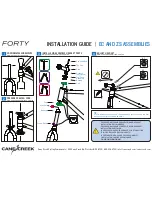
9.1 Cabling Requirements
Cables must be routed according to the specified cabling requirements to prevent signal
interference.
NOTE
If a cable listed below is not required, skip the routing requirements of the cable.
General Cabling Requirements
The bending radius of the cables must meet the following specifications:
l
The bending radius of the 7/8'' feeder must be more than 250 mm (9.84 in.), and the bending
radius of the 5/4'' feeder must be more than 380 mm (14.96 in.).
l
The bending radius of the 1/4'' jumper must be more than 35 mm (1.38 in.). The bending
radius of the super-flexible 1/2'' jumper must be more than 50 mm (1.97 in.), and the bending
radius of the ordinary 1/2'' jumper must be more than 127 mm (5 in.).
l
The bending radius of the power cable or PGND cable must be at least five times the
diameter of the cable.
l
The bending radius of an fiber optic cable is at least 20 times the diameter of the fiber optic
cable.
l
The bending radius of the signal cable must be at least five times the diameter of the cable.
The cables must be bound as follows:
l
The cables must be bound tightly and neatly. The sheaths of the cables must not be damaged.
l
The cable ties must face the same direction, and those at the same horizontal line must be
in a straight line. Extra length of cable ties must be cut.
l
Labels or nameplates must be attached to the cables after they are installed.
The cables must be routed as follows:
l
Different types of cables must be installed in an untangled and orderly fashion.
l
Different types of cables must be routed in parallel or separated by special objects.
Special Cabling Requirements
Cabling requirements for power cables are as follows:
l
Multiple power cables must be bound when routed.
l
Power cables must be installed in the position specified in engineering design documents.
l
If the length of power cables is insufficient, replace the cables rather than adding connectors
or soldering joints to lengthen the cables.
Cabling requirements for PGND cables are as follows:
l
PGND cables for the base station must be connected to the same ground bar.
l
PGND cables must be buried in the ground or routed indoors. They should not be routed
overhead before they are led into the equipment room.
l
The exterior of the coaxial wire and the shield layer of the shielded cable must have proper
electrical contact with the metal surface of the equipment to which they are connected.
BTS3902E WCDMA
Installation Guide
9 Installing Cables
Issue Draft A (2011-06-30)
Huawei Proprietary and Confidential
Copyright © Huawei Technologies Co., Ltd.
9-3
















































